
Trinidad, Colorado
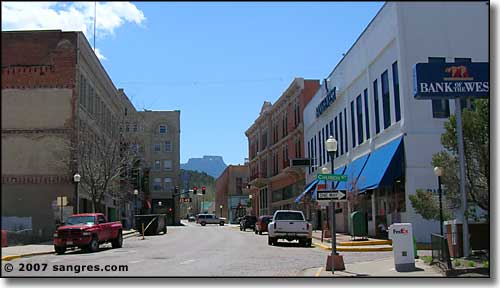
Looking south on Commercial Street, Fisher's Peak in the distance
Trinidad, Colorado is the county seat of Las Animas County. Located between exits 11 and 15 on the I-25 at the foot of Fisher's Peak (elevation: 9,665 ft.), Trinidad is alive with history.
Colonel (later General) Stephen Watts Kearny led his Army of the West through what would become Trinidad in 1846 on his way to take Nuevo Mexico from the Mexicans in the Mexican-American War. Supposedly, that is when Lt. Waldemar Fischer climbed the peak that now bears his name (the spelling was Anglicized, of course), he was trying to discover where he was and if he could see further ahead. (There was some major confusion as to which peak Fischer climbed: the one that now bears his name or a conical-shaped peak further south. In 1887, the US Supreme Court ruled it was the northern peak and that gave about 250,000 acres of disputed land to the European owners of the Maxwell Land Grant. Many settlers had previously paid the Government Land Office for their property in this "disputed zone" but now had to pay the Maxwell Land Grant Co. again for the same land: the GLO gave no refunds for their "mistake.") The Mormon Battalion came through Trinidad then, too, on their way to Santa Fe, La Mesilla and then across southern Arizona to the southern California coast before being released from the Army and then making their way back to Utah. In Civil War times, Lt. John Scoville and other members of his group left their names and initials carved in a sandstone boulder on a ridge just below Fisher's Peak. They were on their way to engage with the Confederates at Glorieta Pass.
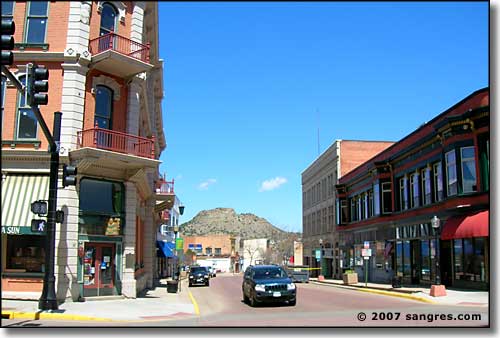
Looking north on Commercial Street
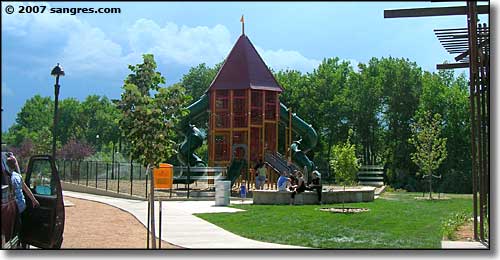
At Jay Cimino Memorial Park, on the Riverwalk
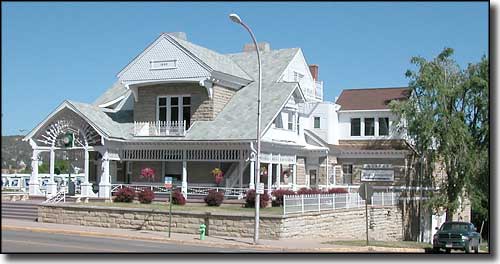
Chappelle Mansion, part of "Millionaire's Row"
Now home to Mullare-Murphy Funeral Home
In 1862, Felipe and Dolores Baca came to Trinidad from Mora, New Mexico with 12 families who settled all up and down the Purgatoire River Valley. The Baca's first settled in the area just northwest of the river, a few blocks north of Main Street so they could take advantage of business opportunities along the Mountain Branch of the Santa Fe Trail, which ran right down Main Street and then turned up the hill and headed south along Gallinas Creek to eventually cross Raton Pass into New Mexico. A few years later Felipe gave Dolores a new gift: he traded $7,000 worth of wool to John Hough (of the Prowers & Hough Mercantile Co., formerly of Boggsville) for the adobe home we now know as the Baca House Museum.
For some folks, Trinidad was very prosperous in those days. When Frank Bloom came to town, he was the manager of his father-in-law's new mercantile in Trinidad. When he left town, he was a land and cattle baron with interests in banking and mining, essentially a millionaire. His rivalry with Felipe Baca is what has left us with the Bloom Mansion on the same block as the Baca House, across the street from the Chappelle Mansion.
In 1872, coal was discovered and a cry went out to Europe for skilled mining labor. The folks who responded formed the basis for the present cultural mix of Hispanic, Italian, Greek, Polish, Irish, Lebanese, Slavic, and other Northern European families. In the early 1900's, the owners of the coal mines were sending agents to Europe to recruit miners right out of the European mines. While promised excellent wages and safe working conditions before they left Europe, the miners arrived in southern Colorado to find low wages, horrific working conditions and living situations completely under the thumbs of the mine owners and their agents. The miners' situation didn't improve until after 1920 when the state of Colorado finally started enforcing their own mine safety laws. At that point, many of the mines closed because John D. Rockefeller (who was the biggest mine operator in the area) refused to invest in safer mining procedures: he thought it cut into his profit margins too much. His efforts to get a monopoly on coal production had been stopped several years earlier anyway when Teddy Roosevelt and Woodrow Wilson started reserving coal seams to the people of the United States through the use of "coal patents" so that the country wouldn't be held for ransom by the folks that Matthew Josephson termed "The Robber Barons" in his great book researching the reasons for the Great Depression. Closing the coal mines didn't hurt Rockefeller and Co. at all: with the general decrease in production they were able to raise prices and turn a bigger profit at lower cost ("Ain't America great?")
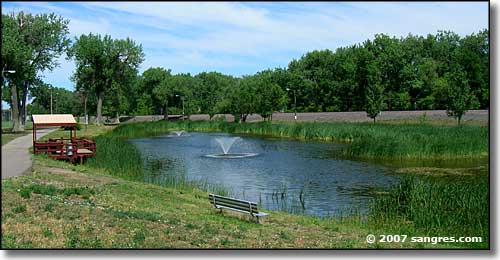
The fishing pond at Central Park (for kids under 14 only)
Trinidad was incorporated in 1876, the same year Colorado became a state. The Barlow and Sanderson Stage Coach ran through town regularly for years, until the Atchison, Topeka & Santa Fe Railroad arrived in 1878. It was a rough and tumble town through these turbulent times but Bat Masterson and other lawmen slowly brought civilization and relative peace to Trinidad (mind you, Bat Masterson drank a bit and liked to shoot out businesses' lights as he strolled back to the hotel late at night, then he'd return in the morning and pay for his damages). Then there were the days late in 1882 when Doc Holliday and the Earp brothers (fresh from the shoot-out at the OK Corral) were hanging out with Masterson in the city's saloons. Once they got Doc's legal problems straightened out a bit they all left town in search of greener pastures, but over the years, each of them passed through Trinidad on a regular basis. Something about good poker and faro games, cheap whiskey and loose women... Clay Allison (cowboy, famous gunfighter/vigilante and resident of the Cimarron, NM area) was also a regular in those days: seems he'd picked up a social disease in Trinidad's red light district and the best doctors in the West were in Trinidad (as were the best engineers, the best architects...)
By the early 1900's, the red light district, the gamblers and most of the saloons were relegated to the area of West Main Street where the Fox Theater, the Safeway, the Sonic Drive In and the Trinidad Motor Inn are now. President Theodore Roosevelt came to visit for a few days in May, 1903, and discovered one of his former Rough Riders in jail on a murder charge (the Rough Rider was later acquitted as he'd shot the poor poker loser in self defense).
Carry Nation, famous tee-totaling crusader, came to Trinidad in 1906. As she stepped off the train she asked the porter there if she could be taken to "someplace clean and free from the taint of liquor." His response: "Ma'am, I think you got off at the wrong station. You're looking for heaven but this is Trinidad." She stayed long enough to get cursed, slapped in the face, hauled into court for disturbing the peace and then, after paying her fine of $35, she left town again on the train.
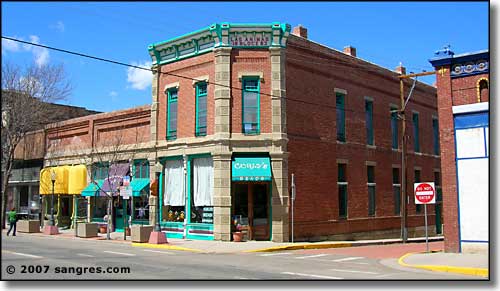
The Las Animas Block, built in 1883
Because of the coal mines, Trinidad was a booming town in those days. It is said that on holiday weekends, the hotels were so full that people were sleeping in the hallways. There was a trolley system that ran from Starkville across Trinidad and out to Sopris and Cokedale. The first airfield was north of Trinidad, east of the I-25, just north of Exit 23. Just before World War II, a new airport was built northeast of Hoehne. Over the years, TWA, Continental and Frontier flew regular schedules out of Trinidad until 1956, when most of the remaining active coal mines closed. There were coal mines that opened intermittently over the years since then but the last big operation closed in 1996. (2007: It seems there's some new money coming in to re-open the New Elk Coal Mine and ship the coal to Japan: the Japanese environmental laws require absolutely clean-burning coal and what we have in the ground beneath us is some of the cleanest-burning coal on Earth. Of course, American businesses don't want to pay the price and our government doesn't require clean coal so...)
In 1970, the Army Corps of Engineers began construction of Trinidad Lake Dam. As part of the program, they had to move several miles of train tracks, seven miles of State Highway 12 and five small towns along the river bottom that were going to be flooded by the lake. When they were finished and filled the lake, we got a great new recreational resource in Trinidad Lake State Park.
The railroad, cattle and agriculture still make up a good portion of Trinidad's industrial base, although coalbed methane has become a major business in the western part of the county and the county's biggest collective employer and taxpayer. Trinidad is also a regional center for education and the arts and a great starting place for fishing, hiking, hunting, and skiing adventures.
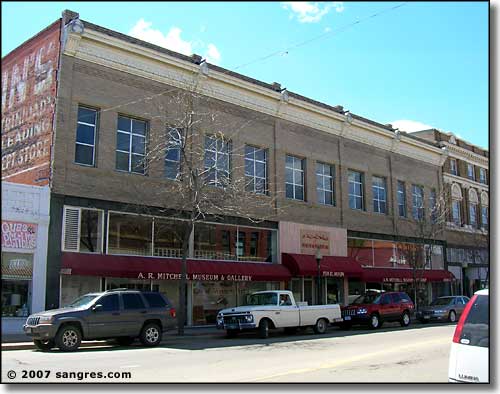
A.R. Mitchell Museum of Western Art
The Museum occupies the main floor and loft area of what was for many years a famous department store (Jameson's). The upper floor contains more exhibit space and several artists' studios with an entrance on 1st Street.
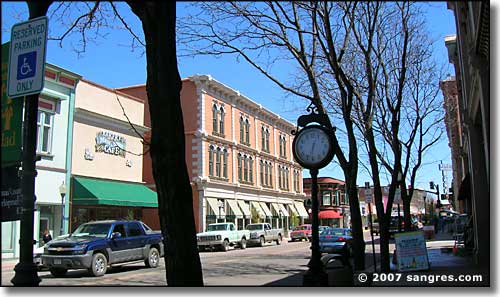
The Columbian Hotel - built in 1879
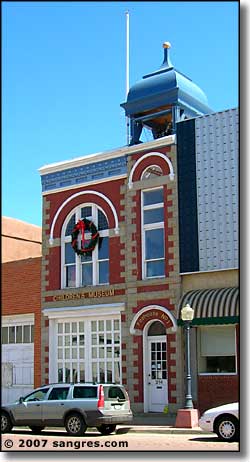
The Columbian is being restored. The offices and shops on the main floor are already filled with businesses and, hopefully, the upper floors of the hotel will soon be available for those who might like to sleep in the same rooms as Wyatt Earp, Doc Holliday, Bat Masterson, Theodore Roosevelt, and Tom Mix, to drop a few of the names that were written in the ledgers here.
The entire downtown of Trinidad, with its' wealth of Victorian architecture, has been declared a National Historic District. In addition to the oldest state college in Colorado, Trinidad State Junior College, the city has five museums, a full service hospital and a state nursing home. There are 11 tennis courts, a municipal swimming pool and a nine hole municipal golf course.
In 2003, Trinidad completed construction of a world-class skateboard park next to the Community Center. In 2007, Tony Hawke rated the Trinidad Skate Park #9 in the world.
West of town on Highway 12, the Scenic Highway of Legends, are Trinidad Lake State Park and, further west, at the foot of the mountains, Monument Lake Park, both prime destinations for fishermen, hikers, boaters, and campers.
Nearby is the San Isabel National Forest, Sugarite (NM) State Park, Vermejo Park Ranch, and the National Rifle Association's Whittington Center.
Angel Fire, Red River, Taos, Sipapu, Wolf Creek, Monarch, and Santa Fe ski areas are all within one to three hours drive. Trinidad also gets daily train service from AmTrak (the Chicago to Los Angeles run). The bridges on which the I-25 crosses town are being replaced, with the project expected to run from January, 2007 to July, 2009 (Update 2008: and they're well behind schedule, with the state not sure they can afford to finish the job).
A number of years ago the Bell Block was burned out, and then was rebuilt and refurbed to the original as much as possible. Now there are restaurant, retail and office suites on the three floors. The building on the right is the Johns Building, now home to the Trinidad-Las Animas County Chamber of Commerce.
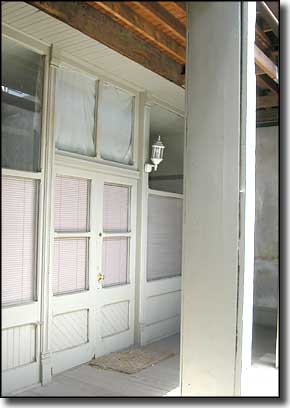
In 1905 downtown Trinidad was ravaged by a flash flood that roared down from Gallinas Canyon. Main Street was raised one block to stop the problem.
The photo at left is taken below the corner of Animas and Main where the original storefronts and boardwalk were kept as they were.
When the Army Corps of Engineers arrived in the late 1960's to build the dam that formed Trinidad Lake, they built on the Purgatoire River a couple miles upstream of where Gallinas Creek flows into the Purgatoire...
- Elevation: 6,010 feet
- Average annual precipitation: 14.0 inches
- Terrain: Mountain valley bridging mountains and high plains
- Days of Sunshine per year: 300+
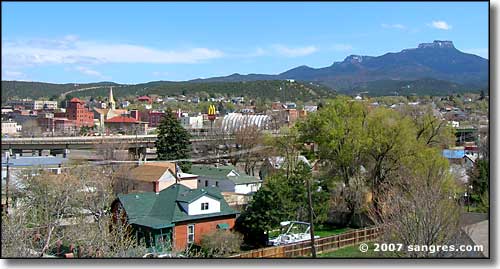
Looking across Trinidad at Fisher's Peak
Latitude: 37.1709°N
Longitude: 104.5064°W
Incorporated: December 30, 1879
Elevation: 6,010'
Education:
High School or Higher: 75.9%
Bachelor's Degree or Higher: 16.8%
Graduate or Professional Degree: 7.1%
2011 Cost of Living Index for Trinidad: 86.1
Estimated Median Household Income: $32,750
Estimated Median Home Value: $119,650
Median Resident Age: 38.9 years
Major Industries:
Lodging & Food Services, Educational Services, Construction, Health Care, Government, Natural Resources, Retail Services, Finance & Insurance Services, Professional Services, Social Services, Rail Transportation
Unemployed (March 2011): 10.3%
Population Demographics: 2010
| Total Population | 9,096 |
| Males | 4,440 |
| Females | 4,656 |
| Population by Age | |
| Under 18 | 2,144 |
| 18 & over | 6,952 |
| 20-24 | 609 |
| 25-34 | 1,022 |
| 35-49 | 1,600 |
| 50-64 | 1,915 |
| 65 & over | 1,466 |
| Population by Ethnicity | |
| Hispanic or Latino | 4,547 |
| Non Hispanic or Latino | 4,549 |
| Population by Race | |
| White | 7,415 |
| African-American | 86 |
| Asian | 78 |
| Native American | 239 |
| Hawaiian or Pacific Islander | 7 |
| Other | 917 |
| Two or more | 354 |
Monument Lake Park - Municipal Golf Course - Trinidad State Junior College
Aguilar - Boncarbo - Branson - Cokedale - Gulnare - Hoehne - Kim - Segundo
Starkville - Stonewall - Weston - Las Animas County - Trinidad Lake State Park
Scenic Highway of Legends - Historic Plazas - State Trust Lands & Wildlife Areas
Bosque del Oso SWA - Spanish Peaks SWA - North Lake & North Fork SWA
Lake Dorothey SWA - San Isabel National Forest - Spanish Peaks Wilderness
National Park Service Sites - BLM Sites - National Wilderness Areas - Unique Natural Features
Outdoor Sports & Recreation - Ski & Snowboard Areas - Photo Galleries - Colorado Mountains
